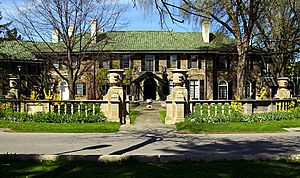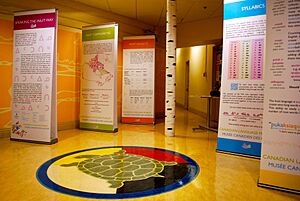Canadian Language Museum facts for kids
| Le Musée canadien des langues | |

Exterior building that houses the Canadian Language Museum
|
|
| Established | 2011 |
|---|---|
| Location | Glendon College, 2275 Bayview Avenue, Toronto, Ontario, Canada |
| Type | Language museum |
The Canadian Language Museum (also known as Le Musée canadien des langues in French) is a special place in Toronto, Ontario, Canada. It's like a treasure chest for all the different languages spoken across Canada! Its main goal is to help everyone understand and appreciate the many languages used here. It also shows how these languages have helped shape the country. The museum started in 2011 and opened its main exhibit area in 2016.
Contents
History of the Museum
The idea for the Canadian Language Museum began in 2007. A linguist named Elaine Gold, along with other Canadian language experts and students from the University of Toronto, helped start it. The museum was officially founded in 2011. This happened at a meeting of the Canadian Linguistic Association. They created a clear plan for what the museum would do.
For its first few years, the museum didn't have its own building. It was like a "museum without walls." Its exhibits traveled to different places all over Canada. In the summer of 2015, the museum opened an office in Toronto. Then, in 2016, it moved into its permanent home. This new space is at Glendon College, which is a bilingual (French and English) campus of York University. Having a permanent home allowed the museum to host guest speakers and educational events. It also meant they could show their own exhibits and host exhibits from other places.
The museum has also been part of the annual meeting of the Canadian Linguistic Association. This meeting happens every May as part of a bigger event called the Congress for the Humanities and Social Sciences.
The museum also shares its mission online. Its website lets people borrow exhibits to display in their own communities. The museum also uses social media and a blog to promote languages. They share stories about protecting languages and the work of Canadian linguists. Their blog features interviews with people across Canada who work to keep languages alive.
Museum Building
The museum is located inside Glendon Hall. This building was once the main house on the estate of the Edward R. Wood family. The museum is at the eastern end of the building. Behind it, there is a beautiful formal rose garden.
Museum Exhibitions
Since it started, the Canadian Language Museum has created a new exhibit each year. These exhibits are always in both French and English. They include exhibits that travel, temporary exhibits, and online exhibits. The museum has also shown exhibits created by other groups and artists.
Travelling Exhibits
When the museum first started, it didn't have its own exhibit space. So, it decided to create exhibits that could travel. This was a great way to share Canada's language history with many people. The travelling exhibits created so far include:
- Canadian English, Eh? (2012)
- Speaking the Inuit Way (2013)
- French in Canada (2014)
- Cree: The People's Language (2015)
- A Tapestry of Voices: Celebrating Canada's Languages (2016)
- Read Between the Signs: 150 Years of Language in Toronto (2017)
- Beyond Words: Dictionaries and Indigenous Languages (2019)
- Sign Languages of Canada (2021)
Students from the University of Toronto Masters of Museum Studies program help create each exhibit. Experts from universities and communities also support these projects. The exhibits are shown at the Canadian Language Museum. They also travel across Canada, from British Columbia to Newfoundland. You can find them in schools, universities, community centers, libraries, airports, hospitals, and small museums.
Temporary Exhibits
The museum created a temporary exhibit called Yiddish Spring in 2019.
Web Exhibits
The museum has two exhibits that you can see online on its website:
- Messages from the Mosaic (2018)
- Anthem: Expressions of Canadian Identity (2020)
Hosted Exhibits
The museum has also hosted art exhibits from other artists:
- Coolie Hauntings by Amar Wahab (2019)
- Legacies: Our Heritage Through Our Grandmother's Eyes by Gina Valle (2019)
- A Newfoundland Treasury of Ice and Snow by Marlene Creates (2018)
- From Smoke to Cyber Signals by Nadine St-Louis (2018)
Supporting Indigenous Languages
A very important part of the Canadian Language Museum's work is to help Indigenous languages. These languages have faced challenges because of colonization. Including Indigenous languages in the museum's programs and exhibits is key to its mission. The museum was founded when the Truth and Reconciliation Commission of Canada was studying how residential schools affected Indigenous languages and culture. The museum works with fluent speakers from Indigenous communities and language experts. This helps them create exhibits in a respectful way. In 2019, the museum published a booklet called Indigenous Languages in Canada. This was to celebrate the International Year of Indigenous Languages. The booklet was written by Professor Will Oxford, a board member of the museum. It is 35 pages long and is available on the museum's website. It talks about the special features, writing systems, and ongoing life of Indigenous languages in Canada.
See also


